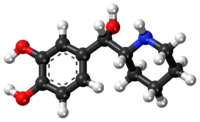Rimiterol
From Wikipedia, the free encyclopedia
 |
|
 |
|
| Clinical data | |
|---|---|
| ATC code | R03AC05 (WHO) |
| Identifiers | |
|
|
| CAS Number | 32953-89-2 |
| PubChem (CID) | 36283 |
| ChemSpider | 33366 |
| UNII | 26GIW6ZLPH |
| ChEMBL | CHEMBL1097630 |
| ECHA InfoCard | 100.046.627 |
| Chemical and physical data | |
| Formula | C12H17NO3 |
| Molar mass | 223.268 g/mol |
| 3D model (Jmol) | Interactive image |
|
|
|
|
| |
|
Rimiterol (INN/USAN) is a third-generation[1] short-acting[2][3] β2 agonist.
Synthesis[edit]
See also[edit]
References[edit]
- ^ Palma-Carlos, A. G.; Palma-Carlos, G. S. (1986). "Beta-2-agonists of Third Generation". Allergie et Immunologie. 18 (4): 31–32, 35. PMID 2899434.
- ^ Lai, CK; Twentyman, OP; Holgate, ST (October 1989). "The Effect of an Increase in Inhaled Allergen Dose After Rimiterol Hydrobromide on the Occurrence and Magnitude of the Late Asthmatic Response and the Associated Change in Nonspecific Bronchial Responsiveness". The American Review of Respiratory Disease. 140 (4): 917–23. doi:10.1164/ajrccm/140.4.917. PMID 2572192.
- ^ Ydreborg, SO; Svedmyr, N; Thiringer, G (April 1977). "Comparison of Rimiterol and Terbutaline, Given by Aerosol, in a Long-term Study". Scandinavian Journal of Respiratory Diseases. 58 (2): 117–24. PMID 16339.
| This drug article relating to the respiratory system is a stub. You can help Wikipedia by expanding it. |
